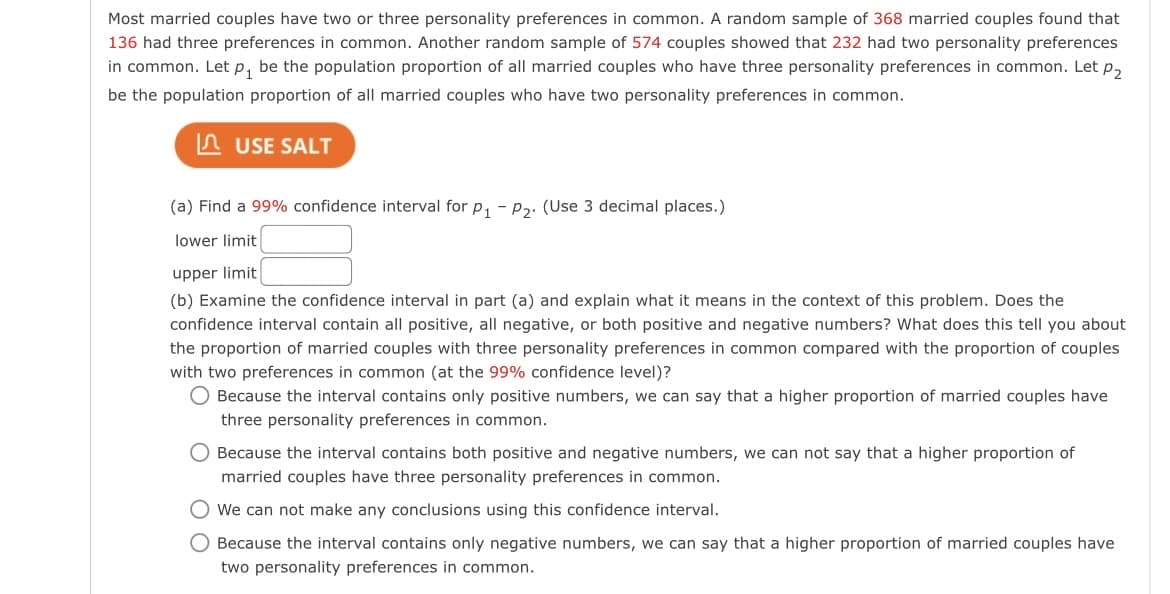Most married couples have two or three personality preferences in common. A random sample of 368 married couples found that 136 had three preferences in common. Another random sample of 574 couples showed that 232 had two personality preferences in common. Let p, be the population proportion of all married couples who have three personality preferences in common. Let p, be the population proportion of all married couples who have two personality preferences in common. n USE SALT (a) Find a 99% confidence interval for p, - p2. (Use 3 decimal places.) lower limit upper limit (b) Examine the confidence interval in part (a) and explain what it means in the context of this problem. Does the confidence interval contain all positive, all negative, or both positive and negative numbers? What does this tell you about the proportion of married couples with three personality preferences in common compared with the proportion of couples with two preferences in common (at the 99% confidence level)? O Because the interval contains only positive numbers, we can say that a higher proportion of married couples have three personality preferences in common. O Because the interval contains both positive and negative numbers, we can not say that a higher proportion of married couples have three personality preferences in common. We can not make any conclusions using this confidence interval. O Because the interval contains only negative numbers, we can say that a higher proportion of married couples have two personality preferences in common. O O
Most married couples have two or three personality preferences in common. A random sample of 368 married couples found that 136 had three preferences in common. Another random sample of 574 couples showed that 232 had two personality preferences in common. Let p, be the population proportion of all married couples who have three personality preferences in common. Let p, be the population proportion of all married couples who have two personality preferences in common. n USE SALT (a) Find a 99% confidence interval for p, - p2. (Use 3 decimal places.) lower limit upper limit (b) Examine the confidence interval in part (a) and explain what it means in the context of this problem. Does the confidence interval contain all positive, all negative, or both positive and negative numbers? What does this tell you about the proportion of married couples with three personality preferences in common compared with the proportion of couples with two preferences in common (at the 99% confidence level)? O Because the interval contains only positive numbers, we can say that a higher proportion of married couples have three personality preferences in common. O Because the interval contains both positive and negative numbers, we can not say that a higher proportion of married couples have three personality preferences in common. We can not make any conclusions using this confidence interval. O Because the interval contains only negative numbers, we can say that a higher proportion of married couples have two personality preferences in common. O O
Holt Mcdougal Larson Pre-algebra: Student Edition 2012
1st Edition
ISBN:9780547587776
Author:HOLT MCDOUGAL
Publisher:HOLT MCDOUGAL
Chapter11: Data Analysis And Probability
Section: Chapter Questions
Problem 8CR
Related questions
Question

Transcribed Image Text:Most married couples have two or three personality preferences in common. A random sample of 368 married couples found that
136 had three preferences in common. Another random sample of 574 couples showed that 232 had two personality preferences
in common. Let p, be the population proportion of all married couples who have three personality preferences in common. Let p,
be the population proportion of all married couples who have two personality preferences in common.
n USE SALT
(a) Find a 99% confidence interval for p, - pɔ. (Use 3 decimal places.)
lower limit
upper limit
(b) Examine the confidence interval in part (a) and explain what it means in the context of this problem. Does the
confidence interval contain all positive, all negative, or both positive and negative numbers? What does this tell you about
the proportion of married couples with three personality preferences in common compared with the proportion of couples
with two preferences in common (at the 99% confidence level)?
O Because the interval contains only positive numbers, we can say that a higher proportion of married couples have
three personality preferences in common.
O Because the interval contains both positive and negative numbers, we can not say that a higher proportion of
married couples have three personality preferences in common.
We can not make any conclusions using this confidence interval.
O Because the interval contains only negative numbers, we can say that a higher proportion of married couples have
two personality preferences in common.
Expert Solution
This question has been solved!
Explore an expertly crafted, step-by-step solution for a thorough understanding of key concepts.
This is a popular solution!
Trending now
This is a popular solution!
Step by step
Solved in 3 steps with 1 images

Recommended textbooks for you

Holt Mcdougal Larson Pre-algebra: Student Edition…
Algebra
ISBN:
9780547587776
Author:
HOLT MCDOUGAL
Publisher:
HOLT MCDOUGAL

College Algebra (MindTap Course List)
Algebra
ISBN:
9781305652231
Author:
R. David Gustafson, Jeff Hughes
Publisher:
Cengage Learning


Holt Mcdougal Larson Pre-algebra: Student Edition…
Algebra
ISBN:
9780547587776
Author:
HOLT MCDOUGAL
Publisher:
HOLT MCDOUGAL

College Algebra (MindTap Course List)
Algebra
ISBN:
9781305652231
Author:
R. David Gustafson, Jeff Hughes
Publisher:
Cengage Learning
